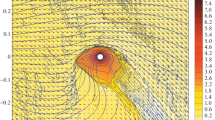Abstract—Currently, hot Jupiters have extended gaseous (ionospheric) envelopes extending far beyond the Roche lobe. The envelopes are loosely bound to the planet and are subject to a strong influence by stellar wind fluctuations. Since hot Jupiters are close to the parent star, the magnetic field of the stellar wind is an important factor which defines the structure of their magnetospheres. For a typical hot Jupiter, the velocity of stellar wind plasma flowing around the atmosphere is close to the Alfvén velocity. Thus, fluctuations of the stellar wind parameters (density, velocity, magnetic field) can affect conditions for the formation of the bow shock around a hot Jupiter, such as transforming the flow from sub-Alfvén to super-Alfvén regime and back. The study results of three-dimensional numerical MHD simulations confirm that, in a hot Jupiter’s envelope located near the Alfvén point of the stellar wind, both the disappearance and appearance of a detached shock can occur under the influence of a coronal mass ejection. The study also shows that this process can affect the observational manifestations of a hot Jupiter, including the radiation flux in the spectrum’s hard region.






Similar content being viewed by others
REFERENCES
R. A. Murray-Clay, E. I. Chiang, and N. Murray, Astrophys. J. 693, 23 (2009).
M. Mayor and D. Queloz, Nature (London, U.K.) 378, 355 (1995).
D. Lai, C. Helling, and E. P. J. van den Heuvel, Astrophys. J. 721, 923 (2010).
S.-L. Li, N. Miller, D. N. C. Lin, and J. J. Fortney, Nature (London, U.K.) 463, 1054 (2010).
A. Vidal-Madjar, A. Lecavelier des Etangs, J.-M. Desert, G. E. Ballester, et al., Nature (London, U.K.) 422, 143 (2003).
A. Vidal-Madjar, A. Lecavelier des Etangs, J.-M. Desert, G. E. Ballester, et al., Astrophys. J. 676, L57 (2008).
L. Ben-Jaffel, Astrophys. J. 671, L61 (2007).
A. Vidal-Madjar, J.-M. Desert, A. Lecavelier des Etangs, G. Hebrard, et al., Astrophys. J. 604, L69 (2004).
L. Ben-Jaffel and S. Sona Hosseini, Astrophys. J. 709, 1284 (2010).
J. L. Linsky, H. Yang, K. France, C. S. Froning, et al., Astrophys. J. 717, 1291 (2010).
R. V. Yelle, Icarus 170, 167 (2004).
A. Garcia Munoz, Planet. Space Sci. 55, 1426 (2007).
T. T. Koskinen, M. J. Harris, R. V. Yelle, and P. Lavvas, Icarus 226, 1678 (2013).
D. E. Ionov, V. I. Shematovich, and Ya. N. Pavlyuchenkov, Astron. Rep. 61, 387 (2017).
D. V. Bisikalo, P. V. Kaigorodov, D. E. Ionov, and V. I. Shematovich, Astron. Rep. 57, 715 (2013).
A. A. Cherenkov, D. V. Bisikalo, and P. V. Kaigorodov, Astron. Rep. 58, 679 (2014).
D. V. Bisikalo and A. A. Cherenkov, Astron. Rep. 60, 183 (2016).
A. Cherenkov, D. Bisikalo, L. Fossati, and C. Möstl, Astrophys. J. 846, 31 (2017).
A. A. Cherenkov, D. V. Bisikalo, and A. G. Kosovichev, Mon. Not. R. Astron. Soc. 475, 605 (2018).
D. V. Bisikalo, A. A. Cherenkov, V. I. Shematovich, L. Fossati, and C. Möstl, Astron. Rep. 62, 648 (2018).
I. F. Shaikhislamov, M. L. Khodachenko, H. Lammer, A. G. Berezutsky, I. B. Miroshnichenko, and M. S. Rumenskikh, Mon. Not. R. Astron. Soc. 481, 5315 (2018).
A. A. Cherenkov, I. F. Shaikhislamov, D. V. Bisikalo, V. I. Shematovich, L. Fossati, and C. Möstl, Astron. Rep. 63, 94 (2019).
A. S. Arakcheev, A. G. Zhilkin, P. V. Kaigorodov, D. V. Bisikalo, and A. G. Kosovichev, Astron. Rep. 61, 932 (2017).
D. V. Bisikalo, A. S. Arakcheev, and P. V. Kaigorodov, Astron. Rep. 61, 925 (2017).
A. G. Zhilkin and D. V. Bisikalo, Astron. Rep. 63, 550 (2019).
W.-H. Ip, A. Kopp, and J.-H. Hu, Astrophys. J. 602, L53 (2004).
P. V. Kaigorodov, E. A. Ilyina, and D. V. Bisikalo, A-stron. Rep. 63, 365 (2019).
W. M. Farrell, J. S. Halekas, R. M. Killen, G. T. Delory, et al., J. Geophys. Res. Planets 117, E00K04 (2012).
C. Möstl, K. Amla, J. R. Hall, P. C. Liewer, et al., Astrophys. J. 787, 119 (2014).
Y. D. Liu, J. D. Richardson, C. Wang, and J. G. Luhmann, Astrophys. J. 788, L28 (2014).
D. Charbonneau, T. M. Brown, D. W. Latham, and M. Mayor, Astrophys. J. 529, L45 (2000).
G. L. Withbroe, Astrophys. J. 325, 442 (1988).
K. G. Kislyakova, M. Holmström, H. Lammer, P. Odert, and M. L. Khodachenko, Science (Washington, DC, U. S.) 346, 981 (2014).
D. J. Stevenson, Rep. Prog. Phys. 46, 555 (1983).
S. Czesla, P. C. Schneider, M. Salz, T. Klocova, T. O. B. Schmidt, and J. H. M. M. Schmitt, Astron. Astrophys. 629, A5 (2019).
ACKNOWLEDGMENTS
The study was carried out using capacities of the collective usage center “Complex for modeling of the data of mega-class research equipment” of the National Research Center “Kurchatov Institute” (http://ckp.nrcki.ru/) and Interdepartmental Supercomputer Center of the Russian Academy of Sciences.
Funding
This study was supported by Russian Foundation for Basic Research (contract № 18-02-00178).
Author information
Authors and Affiliations
Corresponding author
Additional information
Translated by L. Yungelson
Rights and permissions
About this article
Cite this article
Zhilkin, A.G., Bisikalo, D.V. & Kaygorodov, P.V. Coronal Mass Ejection Effect on Envelopes of Hot Jupiters. Astron. Rep. 64, 159–167 (2020). https://doi.org/10.1134/S1063772920020055
Received:
Revised:
Accepted:
Published:
Issue Date:
DOI: https://doi.org/10.1134/S1063772920020055




